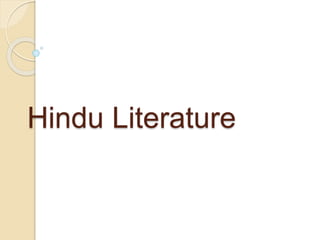
Hindu literature copy
- 2. India World’s 7th largest country located in South Asia Second most populous country. [1,336,286,256 (July 2016 est.)] (17.50%) About 3,000 km(1,865 mi) wide, shoreline about 7000 km (4,350 mi) along Bay of Bengal India and Bharat are both official names. Derives from Indus river used by Greek India civilization grew up in the Indus Valley 4000 to 2500 BC.
- 3. People It is impossible to find out the exact origin of Indian People. The 6 main ethnic groups are as follows. Negrito Proto - Australoids or Austrics Mongoloids Mediterranean or Dravidian Western Brachycephals Nordic Aryans
- 4. Language More than 200 languages are spoken in India 2 official languages at the national level [English and Hindi (spoken by 40% of Indians)] Regional Level South India - Tamil, Telugu, Kannada, Malayalam West India - Marathi, Gujarati, Konkani, Sindhi East India - Oriya, Bengali, Maithili, Assamese, Bodo, Manipuri, Santhali North India - Dogri (in Jammu & Kashmir), Kashmiri, Nepali, Punjabi
- 5. Religion As per the religious census data released by the Registrar General and Census Commissioner of India: Hindu (79.8%) Islam (14.2%) Christian (2.3%) Sikh (1.7%) Buddhist (0.7%) Jain (0.4%) Other religions and persuasions (ORP) (0.7%) religion not stated (0.2%)
- 6. Caste system Indian Caste system – major social system that groups people according to birth ◦ Brahmins: priests, the highest caste ◦ Kshatriyas: warriors and kings ◦ Vaishyas: merchants ◦ Shudras: manual labourers Some people do not fall into any caste; these are called dalits, or untouchables
- 7. Caste system Untouchables also known as Harijans ◦ Dalits have traditionally been tasked with work such as cleaning streets and working with human and animal corpses and waste Caste-based discrimination is now illegal in India, and affirmative-action policies aim to improve standards of living in lower castes
- 8. Education Literacy is higher on man than woman Male literacy rate is 82.14% and Female literacy rate is 65.46% Literacy rate of India is 74.04% Has four levels: lower primary (age 6 to 10) upper primary (11 and 12) high (13 to 15) higher secondary (17 and 18)
- 9. Government Federal system with parliamentary form of government Parliament consist of two houses ◦ The Raiya Sabha (Council of states) ◦ The Lok Sabha (House of the People) Elected directly by eligible voters and sit 5 years unless Parliament is dissolved Indian National Congress- party most identified remained control of the central government
- 10. November 1989 election - Discontent with India’s leadership caused Congress to lose its parliamentary 1991 election- P.V Narasimha Rao succeeded Ravid Gadhi as party leader became prime minister in June 1991
- 11. Literature Sanskrit Literature – Oral Tradition produced the Vedic holy text. Mahabharata and Ramayana – two great books of Hindu Literature 400 B.C. – PANINI produced his Sanskrit grammar Middle Ages Sanskrit – used in religious context by priesthood History of Indian literature falls into 2 periods; 1. The Vedic Period 2. Sanskrit Period
- 12. Religious works Poetry ◦ The Rig Veda: a book of sacred hymns ◦ The Yajur Veda: a book of knowledge and melodies for the hymns ◦ The Sama Veda: descriptions of the materials for sacrifice ◦ The Atharva Veda: contains magic spells and other folk knowledge The Brahmanas The Upanishads Maya The Sutras
- 13. Secular works Epics ◦ The Mahabharata ◦ Bhagavad gita ◦ Nala and Damayanti ◦ The Ramayana Dramas The toy clay cart Sakuntala or the fatal ring The Jatakas The Panchatantra Romanorum The Hitopdesa The Sukasaptati
- 15. Karma and Reincarnation Reincarnation is the belief that the soul repeatedly goes through a cycle of being born into a body, dying, and being reborn again in a new body. Karma, a force that determines the quality of each life, depending on how well one behaved in a past life. Hinduism says we create karma by our actions on earth. If you live a good life, you create good karma. If you live a bad life, you create bad karma.
- 16. Moksha Each time a Hindu soul is born into a better life, it has the opportunity to improve itself further, and get closer to ultimate liberation. This liberation is called Moksha. One attains Moksha when one has "overcome ignorance", and no longer desires anything at all. The ones who reach this state no longer struggle with the cycle of life and death.
- 17. Sacred Writings The Vedas collections of Sanskrit hymns (written down 1200-900BCE, but based on older oral versions). The Upanishads which means the inner or mystic teaching that were passed down from guru (teacher) to disciple (student).
- 18. Mahabharata Mahabharata, Sanskrit for Great Story, is one of the great epic poems of ancient India. It was written between 300 BC and 300 AD. The story is about the battle of one family over a kingdom in northern India. The Bhagavad Gita (Song of God) is contained in the Mahabharata. It is dialogue between Krishna and the hero Arjuna on the meaning of life.
- 19. Ramayana Ramayana was written in 3rd century BC, and tells story of Rama, and his wife, Sita. Rama and Sita are generally seen as ideal examples of great manly heroism and wifely devotion. Reciting the Ramayana is considered a religious act, and scenes from the epic are portrayed throughout India and Southeast Asia.
- 20. Hindu Life Goals Hinduism is about the sort of life one should lead in order to be born into a better life next time and ultimately achieve liberation. There are 4 legitimate goals in life: dharma (appropriate living) artha (the pursuit of material gain by lawful means) kama (delight of the senses) moksha (release from rebirth).
- 21. Hindu Duties Each Hindu has 4 daily duties: Revere the deities Respect ancestors Respect all beings Honor all humankind
- 22. Thank You! ^_^